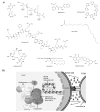Telomerase as a Cancer Target. Development of New Molecules
- PMID: 26873194
- PMCID: PMC4997958
- DOI: 10.2174/1568026616666160212122425
Telomerase as a Cancer Target. Development of New Molecules
Abstract
Telomeres are the terminal part of the chromosome containing a long repetitive and noncodifying sequence that has as function protecting the chromosomes. In normal cells, telomeres lost part of such repetitive sequence in each mitosis, until telomeres reach a critical point, triggering at that time senescence and cell death. However, in most of tumor cells in each cell division a part of the telomere is lost, however the appearance of an enzyme called telomerase synthetize the segment that just has been lost, therefore conferring to tumor cells the immortality hallmark. Telomerase is significantly overexpressed in 80-95% of all malignant tumors, being present at low levels in few normal cells, mostly stem cells. Due to these characteristics, telomerase has become an attractive target for new and more effective anticancer agents. The capability of inhibiting telomerase in tumor cells should lead to telomere shortening, senescence and apoptosis. In this work, we analyze the different strategies for telomerase inhibition, either in development, preclinical or clinical stages taking into account their strong points and their caveats. We covered strategies such as nucleosides analogs, oligonucleotides, small molecule inhibitors, G-quadruplex stabilizers, immunotherapy, gene therapy, molecules that affect the telomere/ telomerase associated proteins, agents from microbial sources, among others, providing a balanced evaluation of the status of the inhibitors of this powerful target together with an analysis of the challenges ahead.
Figures


Similar articles
-
Telomerase: A prominent oncological target for development of chemotherapeutic agents.Eur J Med Chem. 2023 Mar 5;249:115121. doi: 10.1016/j.ejmech.2023.115121. Epub 2023 Jan 13. Eur J Med Chem. 2023. PMID: 36669398 Review.
-
Pharmacological intervention strategies for affecting telomerase activity: future prospects to treat cancer and degenerative disease.Biochimie. 2008 Jan;90(1):156-72. doi: 10.1016/j.biochi.2007.09.002. Epub 2007 Sep 11. Biochimie. 2008. PMID: 17945408 Review.
-
Oligonucleotides and G-quadruplex stabilizers: targeting telomeres and telomerase in cancer therapy.Curr Pharm Des. 2014;20(41):6422-37. doi: 10.2174/1381612820666140630100702. Curr Pharm Des. 2014. PMID: 24975605 Review.
-
Overcoming the immortality of tumour cells by telomere and telomerase based cancer therapeutics--current status and future prospects.Eur J Cancer. 2005 May;41(7):971-9. doi: 10.1016/j.ejca.2004.11.024. Eur J Cancer. 2005. PMID: 15862745 Review.
-
Potential Telomere-Related Pharmacological Targets.Curr Top Med Chem. 2020;20(6):458-484. doi: 10.2174/1568026620666200109114339. Curr Top Med Chem. 2020. PMID: 31916516 Review.
Cited by
-
The Connection Between Cell Fate and Telomere.Adv Exp Med Biol. 2021;1275:71-100. doi: 10.1007/978-3-030-49844-3_3. Adv Exp Med Biol. 2021. PMID: 33539012 Review.
-
New 2,4-bis[(substituted-aminomethyl)phenyl]phenylquinazoline and 2,4-bis[(substituted-aminomethyl)phenyl]phenylquinoline Derivatives: Synthesis and Biological Evaluation as Novel Anticancer Agents by Targeting G-Quadruplex.Pharmaceuticals (Basel). 2023 Dec 25;17(1):30. doi: 10.3390/ph17010030. Pharmaceuticals (Basel). 2023. PMID: 38256866 Free PMC article.
-
Stilbene Compounds Inhibit Tumor Growth by the Induction of Cellular Senescence and the Inhibition of Telomerase Activity.Int J Mol Sci. 2019 Jun 2;20(11):2716. doi: 10.3390/ijms20112716. Int J Mol Sci. 2019. PMID: 31159515 Free PMC article. Review.
-
The hTERT core promoter forms three parallel G-quadruplexes.Nucleic Acids Res. 2020 Jun 4;48(10):5720-5734. doi: 10.1093/nar/gkaa107. Nucleic Acids Res. 2020. PMID: 32083666 Free PMC article.
-
The Relevance of Telomerase and Telomere-Associated Proteins in B-Acute Lymphoblastic Leukemia.Genes (Basel). 2023 Mar 10;14(3):691. doi: 10.3390/genes14030691. Genes (Basel). 2023. PMID: 36980962 Free PMC article. Review.
References
-
- Greider C.W., Blackburn E.H. Identification of a specific telomere terminal transferase activity in Tetrahymena extracts. Cell. 1985;43(2 Pt 1):405–413. - PubMed
-
- Kim N.W., Piatyszek M.A., Prowse K.R., Harley C.B., West M.D., Ho P.L., Coviello G.M., Wright W.E., Weinrich S.L., Shay J.W. Specific association of human telomerase activity with immortal cells and cancer. Science. 1994;266(5193):2011–2015. - PubMed
-
- Mocellin S., Pooley K.A., Nitti D. Telomerase and the search for the end of cancer. Trends Mol. Med. 2013;19(2):125–133. - PubMed
-
- Giraud-Panis M-J., Pisano S., Poulet A., Le Du M-H., Gilson E. Structural identity of telomeric complexes. FEBS Lett. 2010;584(17):3785–3799. - PubMed
Publication types
MeSH terms
Substances
LinkOut - more resources
Full Text Sources
Other Literature Sources
